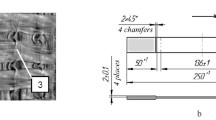Summary
Transient creep recovery tests in simple tension were performed in a series of cross-linked high polymers in pure and plasticized states. A loading cycle was adopted according to which each specimen was loaded in creep for a time period of 16′ followed by recovery for the same time period. This loading cycle was repeated for various steps of temperature from ambient temperature up to a temperature corresponding to the rubbery region of each polymer. It was shown that, while the 15″ measurements of deformation after loading or unloading were approximately equal, recovery individual curves were always lagging in time the corresponding creep curves. Composite curves of creep or recovery deformation in semi-log time scale reduced to a temperature of 30 °C were plotted by applying the method of reduced variables. The creepdeformation composite curve was always advancing in time relatively to the respective recovery composite curve. This phenomenon was an accumulation of the partial difference of the corresponding individual curves.
Time-shift factor versus temperature curves for creep and recovery were plotted and compared.
It was established that the remaining deformation after 16 minutes of a 16′ creep recovery normalized to the initial deformation at the beginning of recovery, if plotted versus temperature, presented the same shape of curves for all types of materials tested. The maxima of these curves were diminishing with addition of plasticizer according to a straight line.
Similar content being viewed by others
References
Bueche, F., Physical Properties of Polymers, pp. 203–206 (New York 1962).
Leadermann, H., Elastic and Creep Properties of Filamentous Materials and Other High Polymers (Washington 1943).
Leadermann, H., J. Polym. Sci.16, 261 (1955).
Martin, G. M., F. L. Roth, andR. D. Stiehler, Trans. Instn. Rubb. Industries32, 189 (1956).
Conant, F. S., G. L. Hall, andW. J. Lyons, J. App. Phys.21, 499 (1950).
Benbow, J. J., The Rheology of Elastomers, P. Mason & N. Wookey Editors, pp. 164–173 (London 1958).
Lodge, A. S., The Rheology of Elastomers, P. Mason and N. Wookey Editors, pp. 70–85 (London 1958).
Kennedy, A. J., J. Mech. Phys. Solids1, 172 (1953).
Ito, K., Trans. Soc. Rheology, J., 253 (1963).
Theocaris, P. S., Rheol. Acta2, p. 92 (1962).
Ferry, J. D., Viscoelastic Properties of Polymers, pp. 203–210 (New York 1961).
Author information
Authors and Affiliations
Rights and permissions
About this article
Cite this article
Theocaris, P.S. Time dependence of creep recovery in cross-linked polymers. Rheol Acta 6, 246–251 (1967). https://doi.org/10.1007/BF01976441
Received:
Issue Date:
DOI: https://doi.org/10.1007/BF01976441



